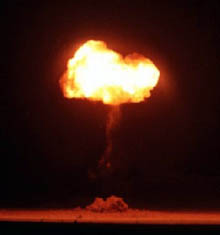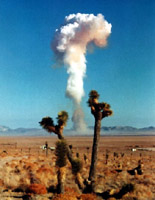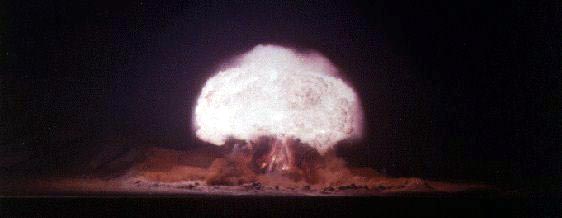 |
|
Operation Hardtack II - 1958

Sorocco - 22/10/1958
|
1958 was a very busy year for nuclear weapons testing by the U.S., with a total of 77 tests, more than the three previous record setting years combined. This burst of testing activity was partly due to building pressure for an imminent test moratorium, leading the weapons labs to rush as many device types to the test range as possible, and partly due to the accelerating momentum of the arms race of the 1950s. 1958 was exceeded only by the 96 tests in 1962, sandwiched as it was between a testing moratorium followed by a surprise moratorium breakout by the Soviet Union in 1961, and the imminent prospect of a permanent atmospheric testing ban.
This second phase of Operation Hardtack was originally to be called Millrace. On 29 August 1958, by AEC directive, the name of the continental portion of the test series was changed to Operation Hardtack Phase II. The Los Alamos (LASL) shots had names taken from New Mexico counties. The Livermore (UCRL) shots had names of North American mountains, Roman gods and goddesses, and the fairies of A Mid-Summer Night's Dream.
Hardtack II included 37 tests, the largest test series so far, exceeding the 35 tests of the just completed Hardtack I. Hardtack I had focused primarily on high yield proof or developemental tests of complete thermonuclear weapons, which necessitated it be conducted in the distant Pacific. In contrast, Hardtack II consisted exclusively of low yield tests, many of them attempted zero-yield one-point safety tests which could be conducted in relative safety in Nevada.
Only 45.8 kt total was fired in Hardtack II, and of this only 18.5 kt was fired above ground. This was a dramatic turnaround from the previous Nevada test series, Plumbbob, in which the above ground Hood shot by itself was 74 kt. Concern about the effects of fallout on the U.S. was certainly making itself felt. Because of the accelerated testing timetable, as many as four detonations were held on one day, and all 37 tests being conducted within just 49 days.

De Baca - 26/10/1958
|
Most of the tests were efforts to prove the safety and effectiveness of new "sealed pit" fission primaries and tactical weapons. This task proved extremely difficult, caught between the Scylla of safety (ensuring that accidental detonation of the explosive could not create even a small nuclear yield) and the Charybdis of effectiveness (ensuring that the weapon reached its design yield). Effective designs often proved unsafe, and modifications made to achieve safety often led to fizzles.
As a result, despite the large number of tests, only a fairly small number of application systems were actually under development. For example, at least 10 shots were conducted to verify the safety and effectiveness of a primary for the XW-54 warhead. No more than 7 design types account for at least 29 of the tests. This series included tests of what is probably the lightest nuclear system feasible - the XW-51 Davy Crockett warhead - weighing only 16 kg in its tested form.
The world's first underground nuclear test had been fired in the previous NTS series (Plumbbob Ranier), this series introduced underground testing as a routine procedure. The intention was to reduce the fallout effects of the testing, which were raising great concern, but the "underground" testing procedures were still relatively primitive. Many of these shots were conducted in "unstemmed" holes, that is, holes not back-filled and sealed prior to testing.
These shots were called "roman candles" since the incandescent gas from the fireball was ejected as a jet from the mouth of the shaft. Obviously fallout containment was much less than perfect, but most of the fission product was nonetheless deposited in the shaft instead of escaping, and the radiation that did escape was not lofted so that it could travel far downwind.
Hardtack Phase II still released some 3,140 kilocuries of radioiodine into the atmosphere (about equal to the Trinity test), and only 5% as much as the previous test series (Plumbbob). This radiation also did not spread nearly as far, only about one-millionth as much radiation exposure occurred to civilians.
One of the weapons-related events, a 460 meter balloon shot called Adams, was scheduled for detonation on 31 October. The device was lowered and disarmed after midnight, however, because it had been determined that extensive overpressure damage to the nearby town of Indian Springs would have resulted from the detonation.

Santa Fe - 30/10/1958
|
Test Shots
| Video |
Name |
Yield |
Date |UTC| |
Type |
Warhead |
Location |
LONG/LAT |
| - |
Otero |
0.038 Kt |
20:00 12/09/1958 |
Shaft @-150m |
XW-54 |
NTS Area 3q |
37.05000 -116.03190 |
| - |
Bernalillo |
0.015 Kt |
19:30 17/09/1958 |
Shaft @-150m |
- |
NTS Area 3h |
37.04940 -116.03300 |
| - |
Eddy |
0.083 Kt |
14:00 19/09/1958 |
Baloon @150m |
- |
NTS Area 7b |
37.08670 -116.02360 |
| - |
Luna |
0.0015 Kt |
19:00 21/09/1958 |
Shaft @-150m |
XW-54 |
NTS Area 3m |
37.04920 -116.03360 |
| - |
Mercury |
0 Kt |
22:00 23/09/1958 |
Shaft @-55m |
XW-47 |
NTS Area 12f |
37.19310 -116.20060 |
| - |
Valencia |
0.002 Kt |
20:00 26/09/1958 |
Shaft @-150m |
XW-42 |
NTS Area 3r |
37.04970 -116.02970 |
| - |
Mars |
0.013 Kt |
00:00 28/09/1958 |
Tunnel @-42m |
XW-48 |
NTS Area 12f |
37.19310 -116.20060 |
| - |
Mora |
2 Kt |
14:05 29/09/1958 |
Baloon @460m |
XW-54 |
NTS Area 7b |
37.08670 -116.02360 |
| - |
Hidalgo |
0.077 Kt |
14:10 05/10/1958 |
Baloon @110m |
- |
NTS Area 7b |
37.08670 -116.02360 |
| - |
Colfax |
0.0055 Kt |
16:15 05/10/1958 |
Shaft @-150m |
- |
NTS Area 3k |
37.04890 -116.03420 |
| - |
Tamalpais |
0.072 Kt |
22:00 08/10/1958 |
Tunnel @-124m |
XW-48 |
NTS Area |
37.19530 -116.20030 |
| - |
Quay |
0.079 Kt |
14:30 10/10/1958 |
Tower @30m |
XW-50 |
NTS Area 7c |
37.09470 -116.02360 |
| - |
Lea |
1.4 Kt |
13:20 16/10/1958 |
Baloon @460m |
XW-54 |
NTS Area 7b |
37.08670 -116.02360 |
| - |
Neptune |
0.155 Kt |
18:00 14/10/1958 |
Tunnel @-30m |
XW-47 |
NTS Area 12c |
37.19390 -116.19970 |
| - |
Hamilton |
0.0012 Kt |
16:00 15/10/1958 |
Tower @15m |
XW-51 |
NTS Area 5 |
36.80220 -115.93220 |
| - |
Logan |
5 Kt |
06:00 16/10/1958 |
Tunnel @-283m |
- |
NTS Area 12e |
37.18420 -116.20110 |
 |
Dona Ana |
0.037 Kt |
14:20 16/10/1958 |
Baloon @150m |
- |
NTS Area 7b |
37.08670 -116.02360 |
| - |
Vesta |
0.024 Kt |
23:00 17/10/1958 |
Surface |
XW-47 |
NTS Area 9e |
37.12250 -116.03470 |
| - |
Rio Arriba |
0.090 Kt |
14:25 18/10/1958 |
Tower @20m |
Mk-7 |
NTS Area 3s |
37.04110 -116.02580 |
| - |
San Juan |
0 Kt |
14:30 20/10/1958 |
Shaft @-70m |
XW-42 |
NTS Area 3p |
37.04470 -116.02970 |
| - |
Socorro |
6 Kt |
13:30 22/10/1958 |
Baloon @460m |
XW-54 |
NTS Area 7b |
37.08670 -116.02360 |
 |
Wrangell |
0.115 Kt |
16:50 22/10/1958 |
Baloon @460m |
XW-47 |
NTS Area 5 |
36.79810 -115.92890 |
| - |
Oberon |
0 Kt |
20:30 22/10/1958 |
Tower @8m |
XW-47 |
NTS Area 8a |
37.20000 -116.10000 |
 |
Rushmore |
0.188 Kt |
23:40 22/10/1958 |
Baloon @150m |
XW-47 |
NTS Area 9a |
37.13470 -116.04080 |
| - |
Catron |
0.021 Kt |
15:00 24/10/1958 |
Tower @20m |
- |
NTS Area 3t |
37.04310 -116.02690 |
| - |
Juno |
0.0017 Kt |
16:01 24/10/1958 |
Surface |
- |
NTS Area 9f |
37.12330 -116.03780 |
| - |
Ceres |
0.0007 Kt |
04:00 26/10/1958 |
Tower @8m |
XW-48 |
NTS Area 8b |
37.18140 -116.06860 |
 |
Sanford |
4.9 Kt |
10:20 26/10/1958 |
Baloon @460m |
XW-47 |
NTS Area 5 |
36.79810 -115.92890 |
| - |
De Baca |
2.2 Kt |
16:00 26/04/1958 |
Baloon @460m |
- |
NTS Area 7b |
37.08670 -116.02360 |
| - |
Chavez |
0.0006 Kt |
14:30 27/10/1958 |
Tower @16m |
- |
NTS Area 3u |
37.05000 -116.00000 |
| - |
Evans |
0.055 Kt |
00:00 29/10/1958 |
Tunnel @256m |
XW-47 |
NTS Area 12b |
37.19470 -116.20470 |
| - |
Mazama |
0 Kt |
11:20 29/10/1958 |
Tower @15m |
- |
NTS Area 9 |
37.10000 -116.05000 |
 |
Humbodt |
0.0078 Kt |
14:45 29/10/1958 |
Tower @10m |
XW-51 |
NTS Area 3v |
37.04780 -116.02470 |
| - |
Santa Fe |
1.3 Kt |
03:00 30/10/1958 |
Baloon @460m |
- |
NTS Area 7b |
37.08670 -116.02360 |
| - |
Ganymede |
0 Kt |
11:00 30/10/1958 |
Surface |
W-45 |
NTS Area 9g |
37.10000 -116.05000 |
| - |
Blanca |
22 Kt |
15:00 30/10/1958 |
Tunnel @-254m |
W-47 |
NTS Area 12e |
37.18580 -116.20190 |
| - |
Titania |
0.0002 Kt |
20:34 30/10/1958 |
Tower @8m |
W-47 |
NTS Area 8c |
37.17720 -116.06920 |

| - DNA 6026F - Defense Nuclear Agency report - Hardtack II
|
|
|
|
 |





